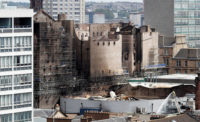Harvard ended 2008 a little less rich. The world's wealthiest university announced in December that its endowment had shrunk from $36.9 billion to $28.8 billion during the second half of the year. In light of that asset plunge and the general economic malaise, the school is reconsidering the scope and timing of its ambitious expansion plans. Even the 1-million-square-foot, $1 billion science complex designed by Behnisch Architekten, already under construction and originally slated for completion in 2011, is under the microscope, according to spokesman Joshua Poupore.

At Princeton University, completion dates for several projects, including elements of a new arts and transit neighborhood (above), have been pushed back.
Harvard’s dilemma reflects the hard reality that universities and other non-profits, until recently the most recession-proof consumers of design and construction services, are cutting back. The American Institute of Architects’ market data, the Architecture Billings Index (ABI), reflects this drop-off. The institutional sector's most recent ABI score, from November, was 40.8, down from 41.3 in October and 44.4 in September. A number above 50 indicates an increase in billing activity, and below 50, a decrease. Prior to August 2008, the last time the institutional score had dipped below 50 was in December 2004.
“As recently as several months ago it was looking like institutional was holding up pretty well and the sector might actually get through this downturn unscathed,” says Kermit Baker, the AIA’s chief economist. Yet the equities meltdown has hammered endowments, obliging universities to divert funds from capital projects to financial aid, faculty salaries, and other core needs, Baker notes. Institutions are also finding it difficult to line up loans, issue bonds, and attract donors.
Princeton has trimmed $300 million, or 12 percent, of its capital plan budget and delayed by a year the mid-2009 start on neuroscience and psychology buildings designed by Raphael Moneo, says director of media relations Cass Cliatt. Several other projects, including elements of a new arts and transit neighborhood with buildings by Steven Holl, have been pushed beyond the master plan’s 2016 horizon.
MIT anticipates spending cuts on the order of 10 to 15 percent over the next several years. But Fumihiko Maki’s Media Lab expansion, Moore Ruble Yudell’s Sloan School expansion, and Ellenzweig’s David H. Koch Institute for Integrative Cancer Research, all under construction, should proceed on schedule, according to officials.
Although the recession may drive down construction costs, university real estate planners can’t count on that as a silver lining, given the economy’s volatility. As a result, analysts say schools are expected to favor renovation and expansion over new construction.
Read more economic coverage in our special section, Recession Reports.




Post a comment to this article
Report Abusive Comment